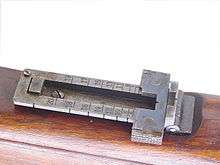Mauser Model 1895
| Mauser Model 1895 | |
|---|---|
| Type | Bolt-action rifle |
| Place of origin | German Empire |
| Service history | |
| In service | 1895– |
| Used by | See Users |
| Wars | |
| Production history | |
| Designed | 1895 |
| Manufacturer |
Ludwig Loewe & Company 1895-1896 Deutsche Waffen und Munitionsfabriken 1897-1900 |
| Produced | 1895– |
| Variants |
Mauser Model 1895 Short Rifle Mauser Model 1895 Carbine |
| Specifications | |
| Weight | 3.9 kg (8.6 lb) |
| Length | 1,220 mm (48.03 in) |
| Barrel length | 740 mm (29.13 in) |
|
| |
| Cartridge | 7×57mm Mauser |
| Action | Bolt-action |
| Muzzle velocity | 700 m/s (2,297 ft/s) |
| Effective firing range | 500 m (550 yd) with iron sights |
| Feed system | 5-round stripper clip, internal magazine |
| Sights | Iron sights. |
The Mauser Model 1895 adopted as Fusil Mauser Chileno Mo 1895.[1] by Chilean forces, is a bolt operated magazine fed rifle using the 7×57mm Mauser cartridge. It is the first major modification of the Mauser Model 1893 and was produced by Deutsche Waffen und Munitionsfabriken, known as DWM, and Ludwig Loewe Company during the period of 1895-1900[2]
History
First supplied by the Ludwig Loewe & Co during 1895-1896 then later by the DWM (1897-1900), the Mauser model 1895 first made its appearance during a small arms race between Argentina and Chile in 1896 and 1898.[2] In this period, over 80,000 Model 1895 rifles and 30,000 Model 1895 carbines were shipped and deployed to the Chilean army.[2] The Model 1895 was also deployed to republic of the Orange Free State and the South African Republic (more commonly known as “Transvaal”) by DWM shortly after the Jameson Raid in December 1895 to deal with the shortage of modern magazine fed rifles for the state army.[1] Roughly 50,000 Mauser rifles were ordered but only 37,000 were delivered because DWM diverted them to fulfill their contract with the Chilean army.[2] Due to many rifles being diverted to Chile, many of the rifles there have the inscription “O.V.S” (Oranje Vrij Staat), Orange Free State. The Model 1895 brought to the “Transvaal” was also known as "Boer Model" Mauser[3] and were marked “O.V.S” (Oranje Vrij Staat) just above the serial number accompanied by MOD.MAUSER and the date of the manufacturer. Due to this, a misunderstanding occurred regarding the identification between the Model 1896 and Model 1897. At the time, an Afrikaans farmer (Also known as a Boer) could purchase a Mauser Model 1895 at a price of £3, another variant known in Afrikaans as Plezier Mauser was sold slightly above cost by the respective governments and private dealers for sport and private use.[4] These rifles varied in strock style, barrel, sight lines and ornamentation. Some of the last rifles delivered by DWM were equipped with turned down bolt handles which made them suitable for the South African farmers on horseback. Work on the manufacturing of the Mauser Model 1895 was halted in 1899 by the Second Boer War.[1] The Mauser Model 1895 also saw service in Mexico, Costa Rica, Paraguay, Iran, El Salvador and Honduras[1]
Design

The Mauser Model 1895 is a modification of the Mauser Model 1893. The flush-mounted staggered column box magazine has a capacity of 5 smokeless powder 7×57mm Mauser cartridges (which is the only 19th century military cartridge still commonly used in sporting rifles,[5]). The magazine can be loaded from a stripper clip, or with individual rounds. The stock has a straight wrist and a handguard which stretches from the receiver ring to the lower barrel band. The upper band has a lug for the Model 1895 bayonet. The Model 1895 differed from the Mauser Model 1893 with regards to the bolt face. The bolt face used in the Mauser Model 1893 was square whereas the Model 1895’s was cylindrical, this is due to the fact that the square face was unnecessary for reliable feeding. In addition, the Model 1895 had an auxiliary shoulder behind the bolt handle in order to provide additional locking in case of bolt failure.[3][6] Another major modification regarding the Model 1895 to the Model 1893 was the magazine follower, the tail of which was rounded so that the bolt could be closed on an empty chamber[1] The Mauser Model 1895 iron sight line had an open post type front sight, and a tangent-type rear sight with a rear notch. These standard sight lines consisted of somewhat coarse aiming elements making it suitable for rough field handling, aiming at distant area fire targets and low light usage, but less suitable for precise aiming at distant or small point targets. The rear tangent sight was graduated for 1893 pattern 7×57mm Mauser cartridges loaded with a 11.2-gram (172.8 gr) long round-nosed bullet from 400 to 2,000 m (437 to 2,187 yd) in 100 m (109 yd) increments.
Variants
Model 1895 Short Rifle
Also known as the mosqueton, the Short Rifle is a slightly longer version of the carbine with an overall length of 41.2 inches, a 21.25-inch barrel and a 1,400 m (1,531 yd) rear sight. The only other modifications are a bent bolt handle and sling swivels on the left side of the barrel band and stock.[2]
Model 1895 Carbine
Also known as the Carabina Mauser Chileño Modelo 1895 was primarily designed for cavalry and artillery. This model is similar in design to the Mauser Model 1895 except for the fact that it is smaller. It is only 37.3 inches long with an 18.3 inch barrel. It was also closely related to the short rifle except that the sling swivels are on the left side of the barrel band and on the stock behind the wrist. It also has the same modified form of the bent bolt handle as the short rifle.[2]
Users
 Bolivia[1][2]
Bolivia[1][2] Chile[1][2][3][5][7]
Chile[1][2][3][5][7].svg.png) China[1][2][7]
China[1][2][7].svg.png) Costa Rica[1][2]
Costa Rica[1][2].svg.png) El Salvador[1]
El Salvador[1] Honduras[1][2]
Honduras[1][2] Iran[1]
Iran[1].svg.png) Mexico[1][2][7]
Mexico[1][2][7] Orange Free State[1][2][3][5][7]
Orange Free State[1][2][3][5][7].svg.png) Paraguay[1]
Paraguay[1] South African Republic[1][2][3][5][7]
South African Republic[1][2][3][5][7] Uruguay[1][7]
Uruguay[1][7]
See also
References
- 1 2 3 4 5 6 7 8 9 10 11 12 13 14 15 16 17 Walter, John (2006). Rifles of the World. Krause Publications. pp. 307–310. ISBN 0-89689-241-7.
- 1 2 3 4 5 6 7 8 9 10 11 12 13 14 Robert, Ball (2011). Mauser Military Rifles of the World. Gun Digest Books. pp. 73–76,255. ISBN 1-4402-1544-8.
- 1 2 3 4 5 "The Model 1893/95 "Boer Model" Mauser". Shooting Times. Retrieved 2016-03-18.
- ↑ "Plezier Mauser". RifleShooter. Retrieved 2016-03-18.
- 1 2 3 4 Haas, Frank De; Zwoll, Wayne (2003). Bolt Action Rifles. Krause Publications. pp. 134–141. ISBN 0-87349-660-4.
- ↑ "The Spanish Modelo 1893 Mauser Rifle". Shooting Times. Retrieved 2016-03-18.
- 1 2 3 4 5 6 Kieran. "Weapons of the Second Boer War". Kieran McMullen. Retrieved 2016-03-18.
External links
- Rifles of the World
- Mauser Military Rifles of the World
- Bolt action Rifles
- The Model 1893/95 “Boer Model” Mauser